Recurrence Patterns for Pancreatic Ductal Adenocarcinoma after Upfront Resection Versus Resection Following Neoadjuvant Therapy: A Comprehensive Meta-Analysis
Abstract
1. Introduction
2. Materials and Methods
2.1. Literature Search
2.2. Data Selection, Extraction, Risk of Bias Assessment and Publication Bias Assessment
2.3. Assessment of Study Quality
2.4. Terminology and Definitions
2.5. Statistical Analysis
3. Results
3.1. Neoadjuvant and Adjuvant Therapy
3.2. Resection and Resectability in the NAT Cohort
3.3. Primary Outcome Measure
Sites of Recurrence
3.4. Secondary Outcome Measures
Overall Recurrence
3.5. Time to First Recurrence
3.6. Recurrence-Free Survival
3.7. Meta-Analysis of Pathological Outcomes between NAT and Upfront Surgery
3.8. Heterogeneity and Risk of Bias
4. Discussion
5. Conclusions
Supplementary Materials
Author Contributions
Funding
Conflicts of Interest
Appendix A
| 1 | Adjuvant. mp. or exp Chemotherapy, Adjuvant/or exp Chemoradiotherapy, Adjuvant/ |
|---|---|
| 2 | exp Neoadjuvant Therapy/or neoadjuvant.mp. |
| 3 | Chemo *.mp. |
| 4 | Pancreatic Cancer.mp. or exp Pancreatic Neoplasms/ |
| 5 | exp Carcinoma, Pancreatic Ductal/or Pancreatic adenocarcinoma.mp. |
| 6 | Pancreatectomy.mp. or exp Pancreatectomy/ |
| 7 | Pancreatectomy/or Pancreatic Resection.mp. |
| 8 | pancreaticoduodenectomy.mp. or exp Pancreaticoduodenectomy/ |
| 9 | Whippl *.mp. |
| 10 | exp Recurrence/or exp Neoplasm Recurrence, Local/or Recurrence.mp. |
| 11 | Relapse.mp. or exp Recurrence/ |
| 12 | Failure.mp. or exp Treatment Failure/ |
References
- Garrido-Laguna, I.; Hidalgo, M. Pancreatic cancer: From state-of-the-art treatments to promising novel therapies. Nat. Rev. Clin. Oncol. 2015, 12, 319–334. [Google Scholar] [CrossRef] [PubMed]
- Groot, V.P.; Rezaee, N.; Wu, W.; Cameron, J.L.; Fishman, E.K.; Hruban, R.H.; Weiss, M.J. Patterns, Timing, and Predictors of Recurrence Following Pancreatectomy for Pancreatic Ductal Adenocarcinoma. Ann. Surg. 2018, 267, 936–945. [Google Scholar] [CrossRef] [PubMed]
- Groot, V.P.; Gemenetzis, G.; Blair, A.B.; Ding, D.; Javed, A.A.; Burkhart, R.A. Implications of the Pattern of Disease Recurrence on Survival Following Pancreatectomy for Pancreatic Ductal Adenocarcinoma. Ann. Surg. Oncol. 2018, 25, 2475–2483. [Google Scholar] [CrossRef]
- Sergeant, G.; Ectors, N.; Van Steenbergen, W.; Aerts, R.; Topal, B. Patterns of recurrence after curative resection of pancreatic ductal adenocarcinoma. Eur. J. Surg. Oncol. 2008, 35, 600–604. [Google Scholar]
- Paik, K.Y.; Choi, S.H.; Heo, J.S.; Choi, D.W. Analysis of liver metastasis after resection for pancreatic ductal adenocarcinoma. World J. Gastrointest. Oncol. 2012, 4, 109–114. [Google Scholar] [CrossRef]
- Kang, C.M.; Chung, Y.E.; Park, J.Y.; Sung, J.S.; Hwang, H.K.; Choi, H.J.; Kim, H.; Song, S.Y.; Lee, J. Potential Contribution of Preoperative Neoadjuvant Concurrent Chemoradiation Therapy on Margin-Negative Resection in Borderline Resectable Pancreatic Cancer. J. Gastrointest. Surg. 2012, 16, 509–517. [Google Scholar] [CrossRef]
- Jang, J.-Y.; Han, Y.; Lee, H.; Kim, S.-W.; Kwon, W.; Lee, K.-H.; Oh, D.-Y.; Chie, E.K.; Lee, J.M.; Heo, J.S.; et al. Oncological Benefits of Neoadjuvant Chemoradiation with Gemcitabine Versus Upfront Surgery in Patients with Borderline Resectable Pancreatic Cancer: A Prospective, Randomized, Open-label, Multicenter Phase 2/3 Trial. Ann. Surg. 2018, 268, 215–222. [Google Scholar] [CrossRef]
- Chen, X.; Liu, G.; Wang, K.; Chen, G.; Sun, J. Neoadjuvant radiation followed by resection versus upfront resection for locally advanced pancreatic cancer patients: A propensity score matched analysis. Oncotarget 2017, 8, 47831–47840. [Google Scholar] [CrossRef]
- Bradley, A.; Van Der Meer, R. Upfront Surgery versus Neoadjuvant Therapy for Resectable Pancreatic Cancer: Systematic Review and Bayesian Network Meta-analysis. Sci. Rep. 2019, 9, 4354–4357. [Google Scholar] [CrossRef]
- Gillen, S.; Schuster, T.; Meyer Zum Büschenfelde, C.; Friess, H.; Kleeff, J. Preoperative/Neoadjuvant Therapy in Pancreatic Cancer: A Systematic Review and Meta-analysis of Response and Resection Percentages. PLoS Med. 2010, 7, e1000267. [Google Scholar] [CrossRef]
- Embuscado, E.E.; Laheru, D.; Ricci, F.; Yun, K.J.; de Boom Witzel, S.; Seigel, A.; Flickinger, K.; Hidalgo, M.; Bova, G.S.; Iacobuzio-Donahue, C.A. Immortalizing the complexity of cancer metastasis: Genetic features of lethal metastatic pancreatic cancer obtained from rapid autopsy. Cancer Biol. 2005, 4, 548–554. [Google Scholar] [CrossRef] [PubMed]
- Dholakia, A.S.; Kumar, R.; Raman, S.P.; Moore, J.A.; Ellsworth, S.; McNutt, T.; Laheru, D.A.; Jaffee, E.; Cameron, J.L.; Tran, P.T.; et al. Mapping Patterns of Local Recurrence After Pancreaticoduodenectomy for Pancreatic Adenocarcinoma: A New Approach to Adjuvant Radiation Field Design. Int. J. Radiat. Oncol. Biol. Phys. 2013, 87, 1007–1015. [Google Scholar] [CrossRef]
- Rangarajan, K.; Pucher, P.; Armstrong, T.; Bateman, A.; Hamady, Z. Systemic neoadjuvant chemotherapy in modern pancreatic cancer treatment: A systematic review and meta-analysis. Ann. R. Coll. Surg. Engl. 2019, 101, 453–462. [Google Scholar] [CrossRef] [PubMed]
- Sharma, G.; Whang, E.E.; Ruan, D.T.; Ito, H. Efficacy of Neoadjuvant Versus Adjuvant Therapy for Resectable Pancreatic Adenocarcinoma: A Decision Analysis. Ann. Surg. Oncol. 2015, 22 (Suppl. 3), 1229. [Google Scholar] [CrossRef]
- Moher, D.; Liberati, A.; Tetzlaff, J.; Altman, D.G.; The PRISMA Group. Preferred reporting items for systematic reviews and meta-analyses: The PRISMA statement. PLoS Med. 2009, 6, e1000097. [Google Scholar] [CrossRef] [PubMed]
- Slim, K.; Nini, E.; Forestier, D.; Kwiatkowski, F.; Panis, Y.; Chipponi, J. Methodological index for non-randomized studies (MINORS): Development and validation of a new instrument. ANZ J. Surg. 2003, 73, 712–716. [Google Scholar] [CrossRef]
- Higgins, J.P.T.; Altman, D.G.; Gøtzsche, P.C.; Jüni, P.; Moher, D.; Oxman, A.D.; Savovic, J.; Schulz, K.F.; Weeks, L.; Sterne, J.A.C.; et al. The Cochrane Collaboration’s tool for assessing risk of bias in randomised trials. BMJ 2011, 343, d5928. [Google Scholar] [CrossRef]
- Ikeda, M.; Okusaka, T.; Ito, Y.; Ueno, H.; Morizane, C.; Furuse, J.; Ishii, H.; Kawashima, M.; Kagami, Y.; Ikeda, H. A phase I trial of S-1 with concurrent radiotherapy for locally advanced pancreatic cancer. Br. J. Cancer 2007, 96, 1650–1655. [Google Scholar] [CrossRef] [PubMed]
- Isaji, S.; Mizuno, S.; Windsor, J.A.; Bassi, C.; Fernández-del Castillo, C.; Hackert, T.; Hayasaki, A.; Katz, M.H.G.; Kim, S.; Kishiwada, M.; et al. International consensus on definition and criteria of borderline resectable pancreatic ductal adenocarcinoma 2017. Pancreatology 2018, 18, 2–11. [Google Scholar] [CrossRef] [PubMed]
- Lu, D.S.; Reber, H.A.; Krasny, R.M.; Kadell, B.M.; Sayre, J. Local staging of pancreatic cancer: Criteria for unresectability of major vessels as revealed by pancreatic-phase, thin-section helical CT. Am. J. Roentgenol. 1997, 168, 1439–1443. [Google Scholar] [CrossRef]
- Soweid, A. The borderline resectable and locally advanced pancreatic ductal adenocarcinoma: Definition. Endosc. Ultrasound 2017, 6, 76. [Google Scholar] [CrossRef]
- Chatterjee, D.; Katz, M.H.; Rashid, A.; Varadhachary, G.R.; Wolff, R.A.; Wang, H.; Lee, J.E.; Pisters, P.W.T.; Vauthey, J.; Crane, C.; et al. Histologic grading of the extent of residual carcinoma following neoadjuvant chemoradiation in pancreatic ductal adenocarcinoma. Cancer 2012, 118, 3182–3190. [Google Scholar] [CrossRef] [PubMed]
- Haeberle, L.; Esposito, I. Pathology of pancreatic cancer. Transl. Gastroenterol. Hepatol. 2019, 4, 50. [Google Scholar] [CrossRef] [PubMed]
- Schlitter, A.M.; Esposito, I. Definition of Microscopic Tumor Clearance (R0) in Pancreatic Cancer Resections. Cancers 2010, 2, 2001–2010. [Google Scholar] [CrossRef] [PubMed]
- Groot, V.P.; Blair, A.B.; Gemenetzis, G.; Ding, D.; Burkhart, R.A.; Borel Rinkes, I.H.M.; Yu, J.; Molenaar, I.Q.; Cameron, J.L.; Weiss, M.J.; et al. Recurrence after neoadjuvant therapy and resection of borderline resectable and locally advanced pancreatic cancer. Eur. J. Surg. Oncol. 2019, 45, 1674–1683. [Google Scholar] [CrossRef] [PubMed]
- Yoshiya, S.; Fukuzawa, K.; Inokuchi, S.; Kosai-Fujimoto, Y.; Sanefuji, K.; Iwaki, K.; Motohiro, A.; Itoh, S.; Harada, N.; Ikegami, T.; et al. Efficacy of Neoadjuvant Chemotherapy in Distal Pancreatectomy with En Bloc Celiac Axis Resection (DP-CAR) for Locally Advanced Pancreatic Cancer. J. Gastrointest. Surg. Off. J. Soc. Surg. Aliment. Tract 2019, 1–7. [Google Scholar] [CrossRef] [PubMed]
- Nurmi, A.; Mustonen, H.; Parviainen, H.; Peltola, K.; Haglund, C.; Seppänen, H. Neoadjuvant therapy offers longer survival than upfront surgery for poorly differentiated and higher stage pancreatic cancer. Acta Oncol. 2018, 57, 799–806. [Google Scholar] [CrossRef] [PubMed]
- Fujii, T.; Yamada, S.; Murotani, K.; Kanda, M.; Sugimoto, H.; Nakao, A.; Kodera, Y. Inverse probability of treatment weighting analysis of upfront surgery versus neoadjuvant chemoradiotherapy followed by surgery for pancreatic adenocarcinoma with arterial abutment. Medicine (Baltimore) 2015, 94, e1647. [Google Scholar] [CrossRef]
- Barugola, G.; Partelli, S.; Crippa, S.; Capelli, P.; D’Onofrio, M.; Pederzoli, P.; Falconi, M. Outcomes after resection of locally advanced or borderline resectable pancreatic cancer after neoadjuvant therapy. Am. J. Surg. 2012, 203, 132–139. [Google Scholar] [CrossRef]
- Wickham, H. Tidyverse: Easily Install and Load the ‘Tidyverse’. Available online: https://cran.r-project.org/web/packages/tidyverse/index.html (accessed on 15 January 2020).
- Guido, S. Meta: An R package for meta-analysis. R News 2007, 7, 40–45. [Google Scholar]
- Viechtbauer, W. Conducting meta-analyses in R with the metafor package. J. Stat. Softw. 2010, 36, 1–48. [Google Scholar] [CrossRef]
- Bowden, J.; Jackson, C. MetaAnalyser: An Interactive Visualisation of Meta-Analysis as a Physical Weighing Machine. 2016. Available online: https://cran.r-project.org/web/packages/MetaAnalyser/index.html (accessed on 15 January 2020).
- Higgins, J.P.T.; Thompson, S.G.; Deeks, J.J.; Altman, D.G. Measuring inconsistency in meta-analyses. BMJ Br. Med. J. 2003, 327, 557. [Google Scholar] [CrossRef] [PubMed]
- Rohatgi, A. WebPlotDigitizer 4.0. Available online: https://automeris.io/WebPlotDigitizer (accessed on 15 January 2020).
- Wan, X.; Wang, W.; Liu, J.; Tong, T. Estimating the sample mean and standard deviation from the sample size, median, range and/or interquartile range. BMC Med. Res. Methodol. 2014, 14, 135. [Google Scholar] [CrossRef] [PubMed]
- Lof, S.; Korrel, M.; van Hilst, J.; Alseidi, A.; Balzano, G.; Boggi, U.; Butturini, G.; Casadei, R.; Dokmak, S.; Edwin, B.; et al. Impact of Neoadjuvant Therapy in Resected Pancreatic Ductal Adenocarcinoma of the Pancreatic Body or Tail on Surgical and Oncological Outcome: A Propensity-Score Matched Multicenter Study. Ann. Surg. Oncol. 2019, 27, 1986–1996. [Google Scholar] [CrossRef]
- Nagakawa, Y.; Sahara, Y.; Hosokawa, Y.; Murakami, Y.; Yamaue, H.; Satoi, S.; Unno, M.; Isaji, S.; Endo, I.; Sho, M.; et al. Clinical Impact of Neoadjuvant Chemotherapy and Chemoradiotherapy in Borderline Resectable Pancreatic Cancer: Analysis of 884 Patients at Facilities Specializing in Pancreatic Surgery. Ann. Surg. Oncol. 2019, 26, 1629–1636. [Google Scholar] [CrossRef]
- Sahora, K.; Kuehrer, I.; Eisenhut, A.; Akan, B.; Koellblinger, C.; Goetzinger, P.; Teleky, B.; Jakesz, R.; Peck-Radosavljevic, M.; Ba’ssalamah, A.; et al. NeoGemOx: Gemcitabine and oxaliplatin as neoadjuvant treatment for locally advanced, nonmetastasized pancreatic cancer. Surgery 2011, 149, 311–320. [Google Scholar] [CrossRef]
- Jiang, H.; Du, C.; Cai, M.; He, H.; Chen, C.; Qiu, J.; Wu, H. An Evaluation of Neoadjuvant Chemoradiotherapy for Patients with Resectable Pancreatic Ductal Adenocarcinoma. Hpb Surg. A World J. Hepatic Pancreat. Biliary Surg. 2013, 2013, 298726. [Google Scholar] [CrossRef]
- Papavasiliou, P.; Hoffman, J.P.; Cohen, S.J.; Meyer, J.E.; Watson, J.C.; Chun, Y.S. Impact of preoperative therapy on patterns of recurrence in pancreatic cancer. HPB 2014, 16, 34–39. [Google Scholar] [CrossRef]
- Massucco, P.; Capussotti, L.; Magnino, A.; Sperti, E.; Gatti, M.; Muratore, A.; Sgotto, E.; Gabriele, P.; Aglietta, M. Pancreatic Resections after Chemoradiotherapy for Locally Advanced Ductal Adenocarcinoma: Analysis of Perioperative Outcome and Survival. Ann. Surg. Oncol. 2006, 13, 1201–1208. [Google Scholar] [CrossRef]
- Ferrone, C.R.; Marchegiani, G.; Hong, T.S.; Ryan, D.P.; Deshpande, V.; McDonnell, E.I.; Sabbatino, F.; Santos, D.D.; Allen, J.N.; Blaszkowsky, L.S.; et al. Radiological and Surgical Implications of Neoadjuvant Treatment with FOLFIRINOX for Locally Advanced and Borderline Resectable Pancreatic Cancer. Ann. Surg. 2015, 261, 12–17. [Google Scholar] [CrossRef]
- Versteijne, E.; Suker, M.; Groothuis, K.; Akkermans-Vogelaar, J.M.; Besselink, M.G.; Bonsing, B.A.; Buijsen, J.; Busch, O.R. Preoperative Chemoradiotherapy Versus Immediate Surgery for Resectable and Borderline Resectable Pancreatic Cancer: Results of the Dutch Randomized Phase III PREOPANC Trial. J. Clin. Oncol. 2020, 38, 1763–1773. [Google Scholar] [CrossRef] [PubMed]
- Masui, T.; Doi, R.; Kawaguchi, Y.; Sato, A.; Nakano, K.; Ito, T.; Anazawa, T.; Takaori, K.; Uemoto, S. Concurrent gemcitabine+S-1 neoadjuvant chemotherapy contributes to the improved survival of patients with small borderline-resectable pancreatic cancer tumors. Surg. Today 2016, 46, 1282–1289. [Google Scholar] [CrossRef] [PubMed]
- Ishikawa, O.; Ohhigashi, H.; Takahashi, H.; Ito, Y. Survival 3, 5, and 10 years after adjuvant regional and neoadjuvant chemotherapy in resectable pancreatic cancer patients: An institutional experience. Pancreat. CancerCyst. Neoplasms Endocr. Tumors Diagn. Manag. 2015, 132, 132–137. [Google Scholar]
- Golcher, H.; Brunner, T.B.; Witzigmann, H.; Marti, L.; Bechstein, W.-O.; Bruns, C.; Jungnickel, H.; Schreiber, S.; Grabenbauer, G.G.; Meyer, T.; et al. Neoadjuvant chemoradiation therapy with gemcitabine/cisplatin and surgery versus immediate surgery in resectable pancreatic cancer: Results of the first prospective randomized phase II trial. Strahlenther. Onkol. 2014, 191, 7–16. [Google Scholar] [CrossRef] [PubMed]
- Cho, I.R.; Chung, M.J.; Bang, S.; Park, S.W.; Chung, J.B.; Song, S.Y.; Seong, J.; Hwang, H.K.; Kang, C.M.; Lee, W.J.; et al. Gemcitabine based neoadjuvant chemoradiotherapy therapy in patients with borderline resectable pancreatic cancer. Pancreatol. Off. J. Int. Assoc. Pancreatol. 2013, 13, 539–543. [Google Scholar] [CrossRef] [PubMed]
- Tajima, H.; Ohta, T.; Kitagawa, H.; Okamoto, K.; Sakai, S.; Makino, I.; Kinoshita, J.; Furukawa, H.; Nakamura, K.; Hayashi, H.; et al. Pilot study of neoadjuvant chemotherapy with gemcitabine and oral S-1 for resectable pancreatic cancer. Exp. Ther. Med. 2012, 3, 787–792. [Google Scholar] [CrossRef]
- Katz, M.; Wang, H.; Balachandran, A.; Bhosale, P.; Crane, C.H.; Wang, X.; Pisters, P.W.T.; Lee, J.E.; Vauthey, J.; Abdalla, E.K.; et al. Effect of Neoadjuvant Chemoradiation and Surgical Technique on Recurrence of Localized Pancreatic Cancer. J. Gastrointest. Surg. 2012, 16, 68–79. [Google Scholar] [CrossRef]
- Barbier, L.; Turrini, O.; Gregoire, E.; Viret, F.; Le Treut, Y.; Delpero, J. Pancreatic head resectable adenocarcinoma: Preoperative chemoradiation improves local control but does not affect survival. Hpb Off. J. Int. Hepato Pancreato Biliary Assoc. 2011, 13, 64–69. [Google Scholar] [CrossRef]
- Greer, S.E.; Pipas, J.M.; Sutton, J.E.; Zaki, B.I.; Tsapakos, M.; Colacchio, T.A.; Gibson, J.J.; Wiener, D.C.; Ripple, G.H.; Barth, R.J., Jr.; et al. Effect of Neoadjuvant Therapy on Local Recurrence after Resection of Pancreatic Adenocarcinoma. J. Am. Coll. Surg. 2008, 206, 451–457. [Google Scholar] [CrossRef]
- Moutardier, V.; Moutardier, J.C.; Turrini, O.; Huiart, L.; Viret, F.; Giovannini, M.; Giovannini, M.H.; Magnin, V.; Lelong, B.; Bories, E.; et al. A reappraisal of preoperative chemoradiation for localized pancreatic head ductal adenocarcinoma in a 5-year single-institution experience. J. Gastrointest. Surg. 2004, 8, 502–510. [Google Scholar] [CrossRef]
- Pingpank, J.F.; Hoffman, J.P.; Ross, E.A.; Cooper, H.S.; Meropol, N.J.; Freedman, G.; Pinover, W.H.; LeVoyer, T.E.; Sasson, A.R.; Eisenberg, B.L. Effect of preoperative chemoradiotherapy on surgical margin status of resected adenocarcinoma of the head of the pancreas. J. Gastrointest. Surg. Off. J. Soc. Surg. Aliment. Tract 2001, 5, 121–130. [Google Scholar] [CrossRef]
- Tempero, M.A.; Arnoletti, J.P.; Behrman, S.W.; Ben-Josef, E.; Benson, A.B.; Casper, E.S.; Cohen, S.J.; Czito, B.; Ellenhorn, J.D.I.; Hawkins, W.G.; et al. Pancreatic Adenocarcinoma, Version 2.2012. J. Natl. Compr. Cancer Netw. 2012, 10, 703–713. [Google Scholar] [CrossRef] [PubMed]
- Groot, V.; Gemenetzis, G.; Blair, A.; Rivero-Soto, R.; Yu, J.; Javed, A.; Burkhart, R.; Rinkes, I.H.M.; Molenaar, I.; Cameron, J.; et al. Defining and Predicting Early Recurrence in 957 Patients with Resected Pancreatic Ductal Adenocarcinoma. Ann. Surg. 2019, 269, 1154–1162. [Google Scholar] [CrossRef] [PubMed]
- Iacobuzio-Donahue, C.A.; Fu, B.; Yachida, S.; Luo, M.; Abe, H.; Henderson, C.M.; Vilardell, F.; Wang, Z.; Keller, J.W.; Banerjee, P.; et al. DPC4 Gene Status of the Primary Carcinoma Correlates with Patterns of Failure in Patients with Pancreatic Cancer. J. Clin. Oncol. 2009, 27, 1806–1813. [Google Scholar] [CrossRef] [PubMed]
- Gnerlich, J.L.; Luka, S.R.; Deshpande, A.D.; Dubray, B.J.; Weir, J.S.; Carpenter, D.H.; Brunt, E.M.; Strasberg, S.M.; Hawkins, W.G.; Linehan, D.C. Microscopic Margins and Patterns of Treatment Failure in Resected Pancreatic Adenocarcinoma. Arch. Surg. 2012, 147, 753–760. [Google Scholar] [CrossRef] [PubMed]
- Suker, M.; Beumer, B.R.; Sadot, E.; Marthey, L.; Faris, J.E.; Mellon, E.A.; El-Rayes, B.F.; Wang-Gillam, A.; Lacy, J.; Hosein, P.J.; et al. FOLFIRINOX for locally advanced pancreatic cancer: A systematic review and patient-level meta-analysis. Lancet Oncol. 2016, 17, 801–810. [Google Scholar] [CrossRef]
- Unno, M.; Motoi, F.; Matsuyama, Y.; Satoi, S.; Matsumoto, I.; Aosasa, S.; Shirakawa, H.; Wada, K.; Fujii, T.; Yoshitomi, H.; et al. Randomized phase II/III trial of neoadjuvant chemotherapy with gemcitabine and S-1 versus upfront surgery for resectable pancreatic cancer (Prep-02/JSAP-05). J. Clin. Oncol. 2019, 37, 189. [Google Scholar] [CrossRef]
- Callery, M.P.; Chang, K.J.; Fishman, E.K.; Talamonti, M.S.; William Traverso, L.; Linehan, D.C. Pretreatment Assessment of Resectable and Borderline Resectable Pancreatic Cancer: Expert Consensus Statement. Ann. Surg. Oncol. 2009, 16, 1727–1733. [Google Scholar] [CrossRef]
- Yamada, S.; Fujii, T.; Sugimoto, H.; Nomoto, S.; Takeda, S.; Kodera, Y.; Nakao, A. Aggressive surgery for borderline resectable pancreatic cancer: Evaluation of National Comprehensive Cancer Network guidelines. Pancreas 2013, 42, 1004–1010. [Google Scholar] [CrossRef]
- Assifi, M.M.; Lu, X.; Eibl, G.; Reber, H.A.; Li, G.; Hines, O.J. Neoadjuvant therapy in pancreatic adenocarcinoma: A meta-analysis of phase II trials. Surg. Off. J. Soc. Univ. Surg. Cent. Surg. Assoc. Am. Assoc. Endocr. Surg. 2011, 150, 466–473. [Google Scholar]
- Russo, S.; Ammori, J.; Eads, J.; Dorth, J. The role of neoadjuvant therapy in pancreatic cancer: A review. Future Oncol. 2016, 12, 669–685. [Google Scholar] [CrossRef] [PubMed]
- Heinrich, S.; Schäfer, M.; Weber, A.; Hany, T.F.; Bhure, U.; Pestalozzi, B.C.; Clavien, P. Neoadjuvant chemotherapy generates a significant tumor response in resectable pancreatic cancer without increasing morbidity: Results of a prospective phase II trial. Ann. Surg. 2008, 248, 1014–1022. [Google Scholar] [CrossRef] [PubMed]
- Neoptolemos, J.P.; Palmer, D.H.; Ghaneh, P.; Psarelli, E.E.; Valle, J.W.; Halloran, C.M.; Faluyi, O.; O’Reilly, D.A.; Cunningham, D.; Wadsley, J.; et al. Comparison of adjuvant gemcitabine and capecitabine with gemcitabine monotherapy in patients with resected pancreatic cancer (ESPAC-4): A multicentre, open-label, randomised, phase 3 trial. Lancet 2017, 389, 1011–1024. [Google Scholar] [CrossRef]
- Edeline, J.; Bonnetain, F.; Phelip, J.M.; Watelet, J.; Hammel, P.; Joly, J.; Ben Abdelghani, M.; Rosmorduc, O.; Bouhier-Leporrier, K.; Jouve, J.; et al. Gemox versus surveillance following surgery of localized biliary tract cancer: Results of the PRODIGE 12-ACCORD 18 (UNICANCER GI) phase III trial. J. Clin. Oncol. 2017, 35 (Suppl. 4), 225. [Google Scholar] [CrossRef]
- Katz, M.H.G.; Shi, Q.; Ahmad, S.A.; Herman, J.M.; Marsh, R.D.W.; Collisson, E.; Schwartz, L.; Frankel, W.; Martin, R.; Conway, W.; et al. Preoperative modified FOLFIRINOX treatment followed by capecitabine-based chemoradiation for borderline resectable pancreatic cancer alliance for clinical trials in oncology trial A021101. JAMA Surg. 2016, 151, e161137. [Google Scholar] [CrossRef]
- Okada, K.; Hirono, S.; Kawai, M.; Miyazawa, M.; Shimizu, A.; Kitahata, Y.; Ueno, M.; Hayami, S.; Yamaue, H. Phase I Study of Nab–Paclitaxel plus Gemcitabine as Neoadjuvant Therapy for Borderline Resectable Pancreatic Cancer. Anticancer Res. 2017, 37, 853–858. [Google Scholar] [CrossRef]
- Labori, K.J.; Lassen, K.; Hoem, D.; Grønbech, J.E.; Søreide, J.A.; Mortensen, K.; Smaaland, R.; Sorbye, H.; Verbeke, C.; Dueland, S. Neoadjuvant chemotherapy versus surgery first for resectable pancreatic cancer (Norwegian Pancreatic Cancer Trial—1 (NorPACT-1))—Study protocol for a national multicentre randomized controlled trial. BMC Surg. 2017, 17, 94. [Google Scholar] [CrossRef]
- Schwarz, L.; Vernerey, D.; Bachet, J.-B.; Tuech, J.-J.; Portales, F.; Michel, P.; Cunha, A.S. Resectable pancreatic adenocarcinoma neo-adjuvant FOLF(IRIN)OX-based chemotherapy—A multicenter, non-comparative, randomized, phase II trial (PANACHE01-PRODIGE48 study). BMC Cancer 2018, 18, 762. [Google Scholar] [CrossRef]
- Satoi, S.; Toyokawa, H.; Yanagimoto, H.; Yamamoto, T.; Hirooka, S.; Yamaki, S.; Michiura, T.; Inoue, K.; Matsui, Y.; Kwon, A.H. Neoadjuvant chemoradiation therapy using S-1 for patients with pancreatic cancer. Gastroenterology 2012, 142, S1097–S1098. [Google Scholar] [CrossRef]
- Murphy, J.E.; Wo, J.Y.; Ryan, D.P.; Jiang, W.; Yeap, B.Y.; Drapek, L.C.; Blaszkowsky, L.S.; Kwak, E.L.; Allen, J.N.; Clark, J.W.; et al. Total Neoadjuvant Therapy with FOLFIRINOX Followed by Individualized Chemoradiotherapy for Borderline Resectable Pancreatic Adenocarcinoma: A Phase 2 Clinical Trial. JAMA Oncol. 2018, 4, 963–969. [Google Scholar] [CrossRef]
- He, J.; Blair, A.; Groot, V.; Javed, A.; Burkhart, R.; Gemenetzis, G.; Hruban, R.; Waters, K.; Poling, J.; Zheng, L.; et al. Is a Pathological Complete Response Following Neoadjuvant Chemoradiation Associated with Prolonged Survival in Patients with Pancreatic Cancer? Ann. Surg. 2018, 268, 1–8. [Google Scholar] [CrossRef] [PubMed]
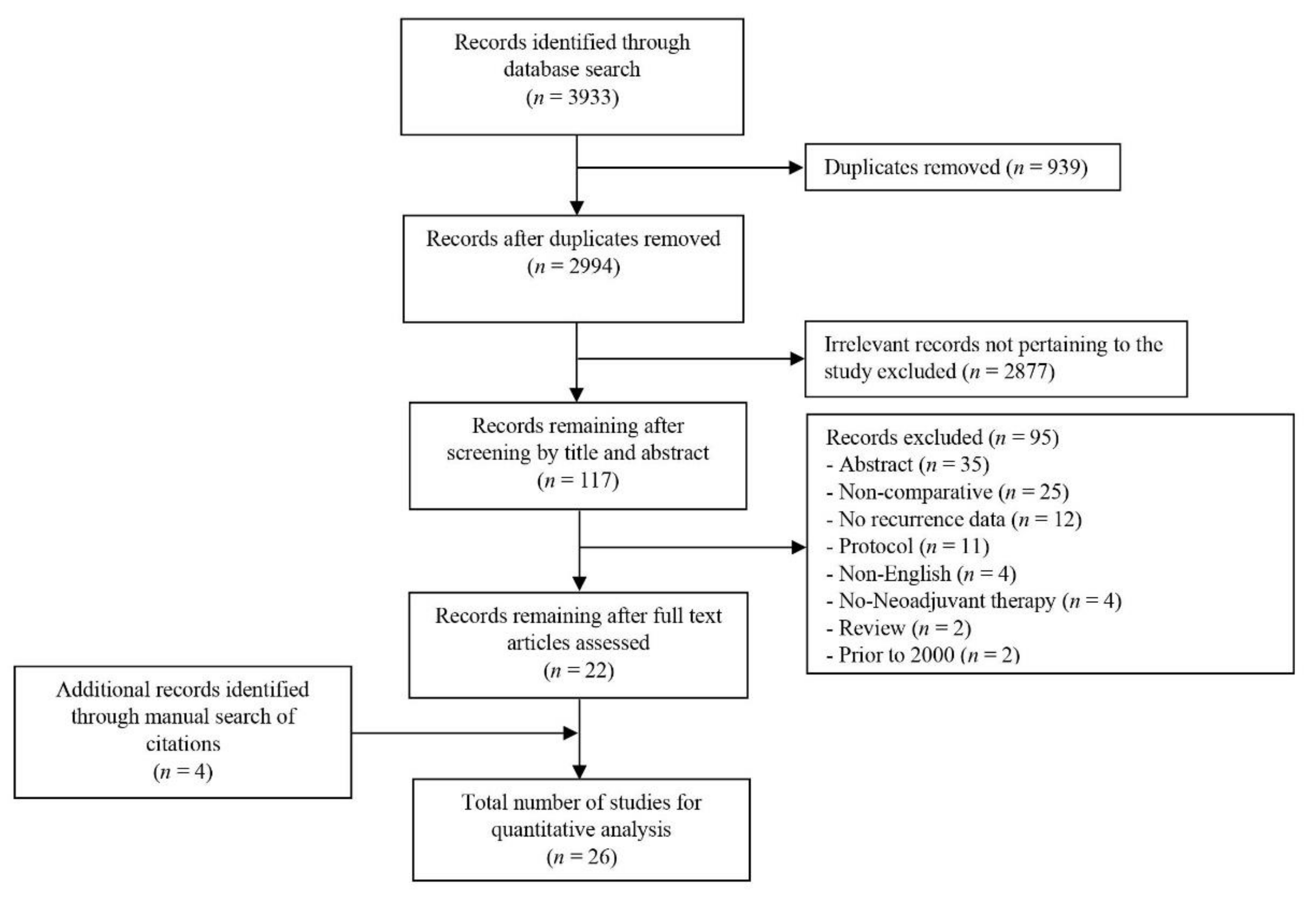
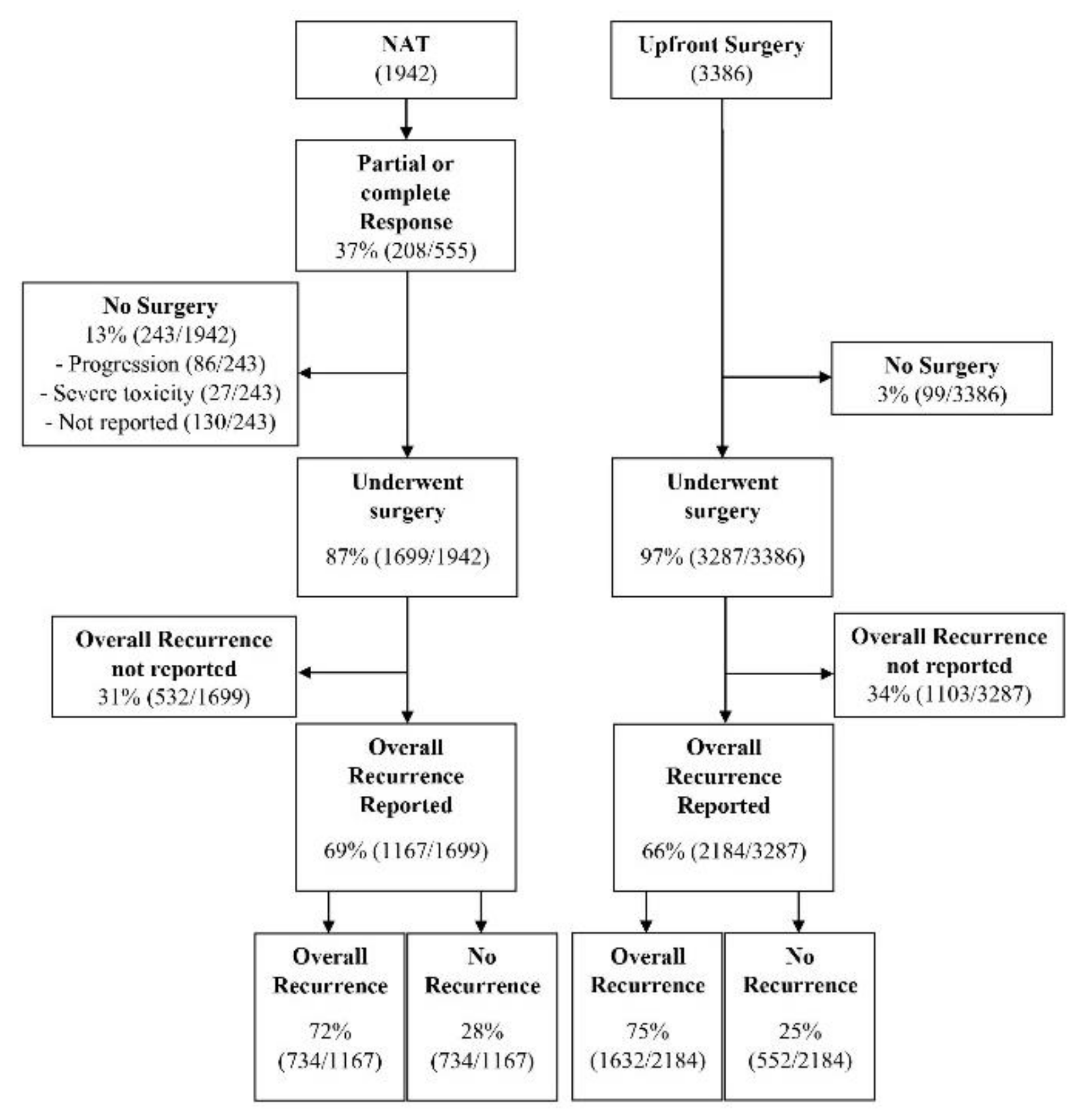
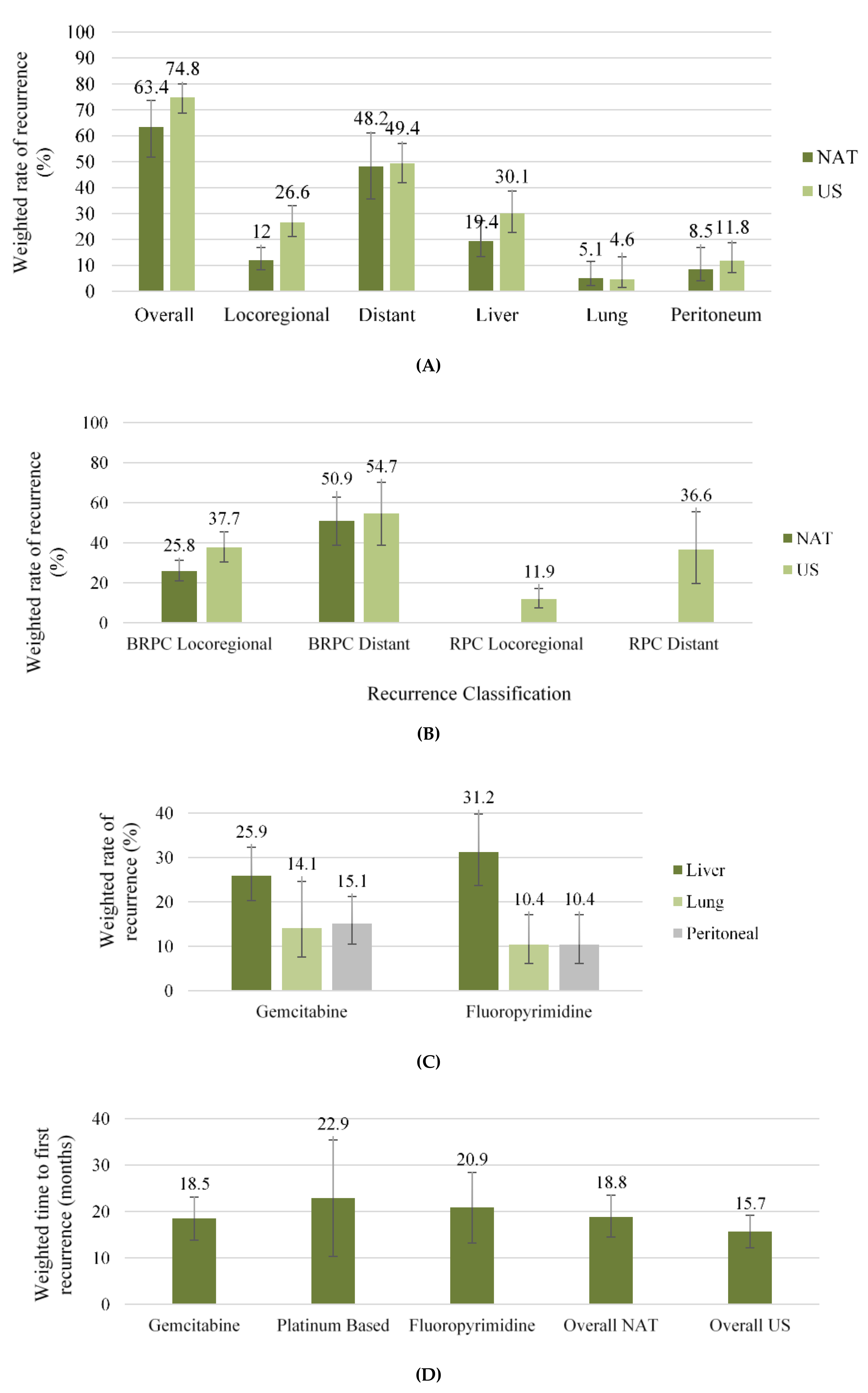
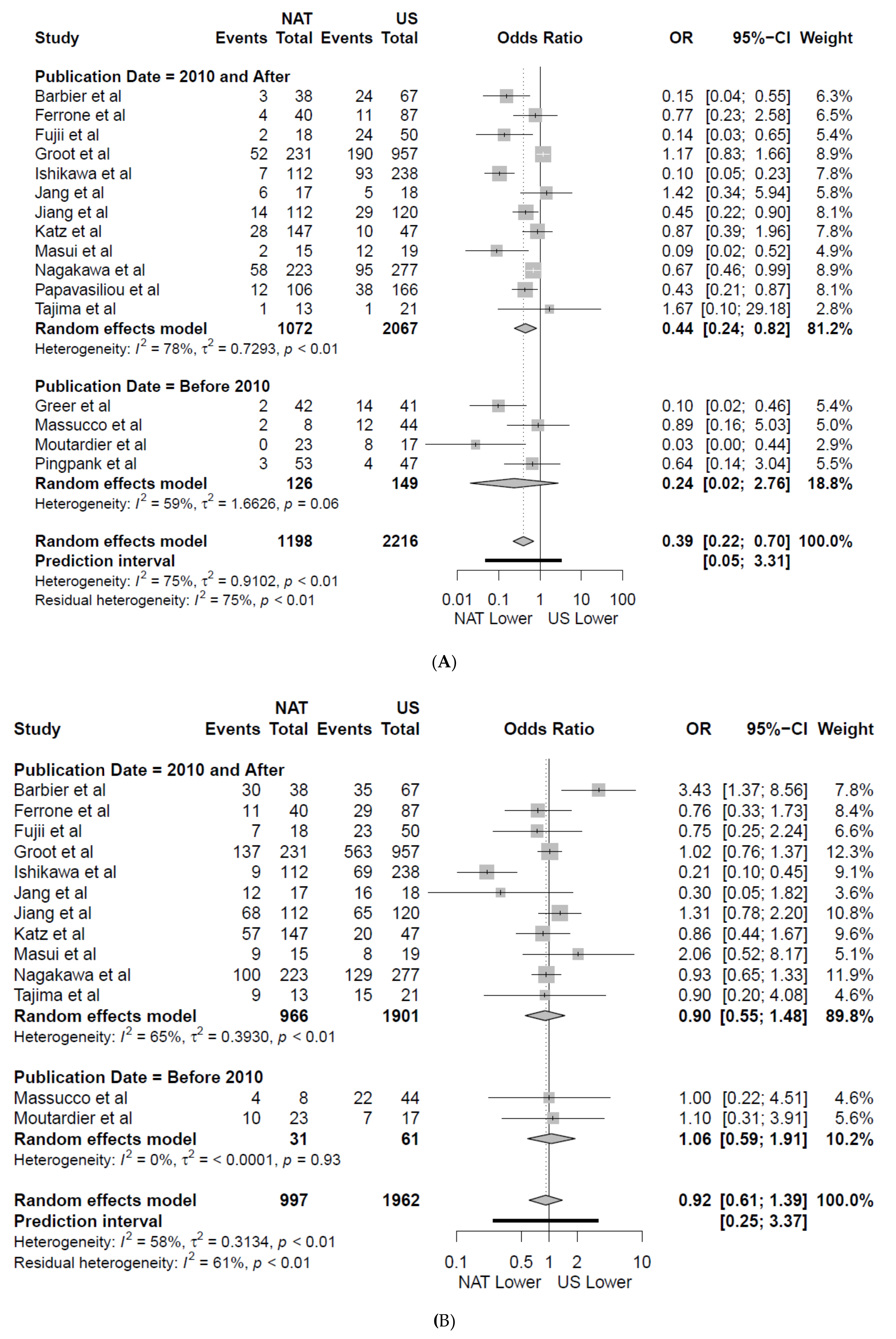
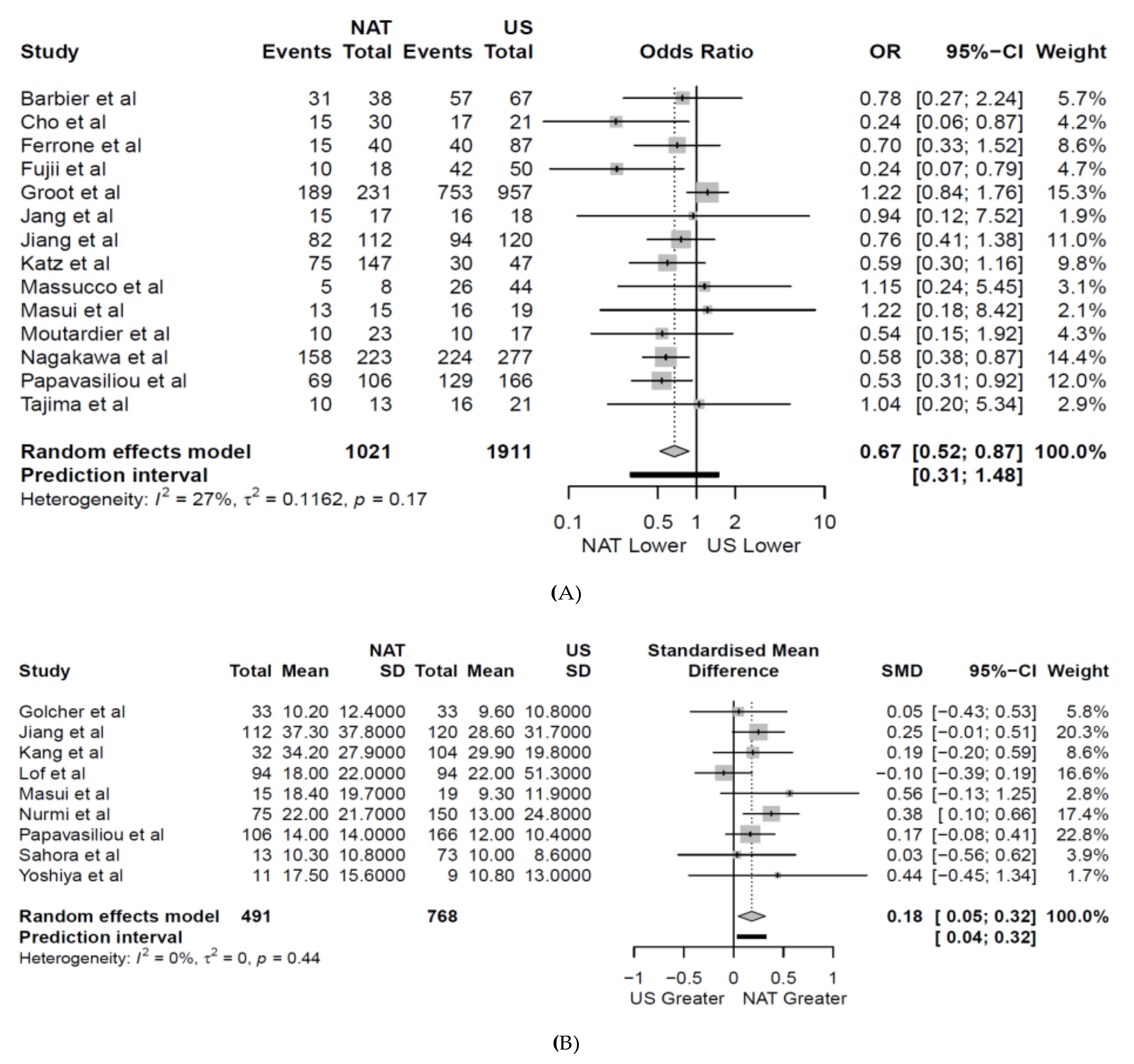
| Author | Publication Year | Country | Study Type (n) | Recruitment Dates | Centres (n) | Total Study Population (n) | Cohorts Undergoing Surgery for Comparison | Total in Quantitative Analysis (n) | |
|---|---|---|---|---|---|---|---|---|---|
| NAT (n) | US (n) | ||||||||
| Versteijne et al. [44] | 2020 | Netherlands | Trial | 2013–2017 | 16 | 246 | 72 | 92 | 164 |
| Lof et al. [37] | 2019 | Europe | Retrospective | 2007–2015 | Multiple | 1236 | 94 * | 94 ± | 188 |
| Yoshiya et al. [26] | 2019 | Japan | Retrospective | 2008–2018 | 1 | 20 | 11 | 9 | 20 |
| Groot et al. [25] | 2019 | USA | Retrospective | 2007–2015 | 1 | 1188 | 231 | 95 * | 1188 |
| Nagakawa et al. [38] | 2019 | Japan | Prospective | 2011–2013 | 63 | 884 | 223 | 27 * | 500 |
| Nurmi et al. [27] | 2018 | Finland | Retrospective | 2000–2015 | 1 | 225 | 75 | 150 * | 225 |
| Jang et al. [7] | 2018 | Korea | Trial | 2012–2014 | 4 | 40 | 17 | 18 | 35 |
| Chen et al. [8] | 2017 | China | Retrospective | 2004–2013 | Multiple | 196 | 98 | 98 * | 196 |
| Masui et al. [45] | 2016 | Japan | Prospective | 2005–2010 | 1 | 37 | 15 | 19 | 34 |
| Ferrone et al. [43] | 2015 | USA | Retrospective | 2011–2014 | 1 | 127 | 40 | 87 | 127 |
| Fujii et al. [28] | 2015 | Japan | Retrospective | 2002–2014 | 1 | 92 | 18 | 50 | 68 |
| Ishikawa et al. [46] | 2015 | Japan | Retrospective | Until 2011 | 1 | 506 | 112 | 238 | 350 |
| Golcher et al. [47] | 2014 | Germany | Trial | 2003–2009 | 1 | 66 | 33 | 33 | 66 |
| Papavasiliou et al. [41] | 2014 | USA | Retrospective | 1990–2009 | 1 | 309 | 108 | 201 | 309 |
| Cho et al. [48] | 2013 | Korea | Retrospective | 2002–2011 | 1 | 51 | 30 | 21 | 51 |
| Jiang et al. [40] | 2013 | China | Retrospective | 2004–2010 | 1 | 232 | 11 β | 120 | 232 |
| Kang et al. [6] | 2012 | Korea | Retrospective | 1999–2010 | 1 | 136 | 32 | 104 | 136 |
| Tajima et al. [49] | 2012 | Japan | Retrospective | 2006–2009 | 1 | 34 | 13 | 21 | 34 |
| Barugola et al. [29] | 2012 | Italy | Retrospective | 2001–2008 | 1 | 403 | 41 | 362 | 403 |
| Katz et al. [50] | 2012 | USA | Retrospective | 2004–2008 | 1 | 147 | 147 | 47 | 194 |
| Barbier et al. [51] | 2011 | France | Retrospective | 1997–2006 | 1 | 173 | 38 | 67 | 105 |
| Sahora et al. [39] | 2011 | Asutria | Retrospective | 2003–2006 | 1 | 106 | 13 | 73 ¥ | 86 |
| Greer et al. [52] | 2008 | Lebanon | Retrospective | 1993–2005 | 1 | 102 | 42 | 41 € | 83 |
| Massucco et al. [42] | 2006 | Italy | Retrospective | 1999–2003 | 1 | 72 | 8 | 44 | 52 |
| Moutardier et al. [53] | 2004 | France | Retrospective | 1997–2002 | 1 | 87 | 23 | 17 | 40 |
| Pingpank et al. [54] | 2001 | USA | Retrospective | 1987–2000 | 1 | 100 | 53 | 47 | 100 |
© 2020 by the authors. Licensee MDPI, Basel, Switzerland. This article is an open access article distributed under the terms and conditions of the Creative Commons Attribution (CC BY) license (http://creativecommons.org/licenses/by/4.0/).
Share and Cite
Ratnayake, B.; Savastyuk, A.Y.; Nayar, M.; Wilson, C.H.; Windsor, J.A.; Roberts, K.; French, J.J.; Pandanaboyana, S. Recurrence Patterns for Pancreatic Ductal Adenocarcinoma after Upfront Resection Versus Resection Following Neoadjuvant Therapy: A Comprehensive Meta-Analysis. J. Clin. Med. 2020, 9, 2132. https://doi.org/10.3390/jcm9072132
Ratnayake B, Savastyuk AY, Nayar M, Wilson CH, Windsor JA, Roberts K, French JJ, Pandanaboyana S. Recurrence Patterns for Pancreatic Ductal Adenocarcinoma after Upfront Resection Versus Resection Following Neoadjuvant Therapy: A Comprehensive Meta-Analysis. Journal of Clinical Medicine. 2020; 9(7):2132. https://doi.org/10.3390/jcm9072132
Chicago/Turabian StyleRatnayake, Bathiya, Alina Y. Savastyuk, Manu Nayar, Colin H. Wilson, John A. Windsor, Keith Roberts, Jeremy J. French, and Sanjay Pandanaboyana. 2020. "Recurrence Patterns for Pancreatic Ductal Adenocarcinoma after Upfront Resection Versus Resection Following Neoadjuvant Therapy: A Comprehensive Meta-Analysis" Journal of Clinical Medicine 9, no. 7: 2132. https://doi.org/10.3390/jcm9072132
APA StyleRatnayake, B., Savastyuk, A. Y., Nayar, M., Wilson, C. H., Windsor, J. A., Roberts, K., French, J. J., & Pandanaboyana, S. (2020). Recurrence Patterns for Pancreatic Ductal Adenocarcinoma after Upfront Resection Versus Resection Following Neoadjuvant Therapy: A Comprehensive Meta-Analysis. Journal of Clinical Medicine, 9(7), 2132. https://doi.org/10.3390/jcm9072132






